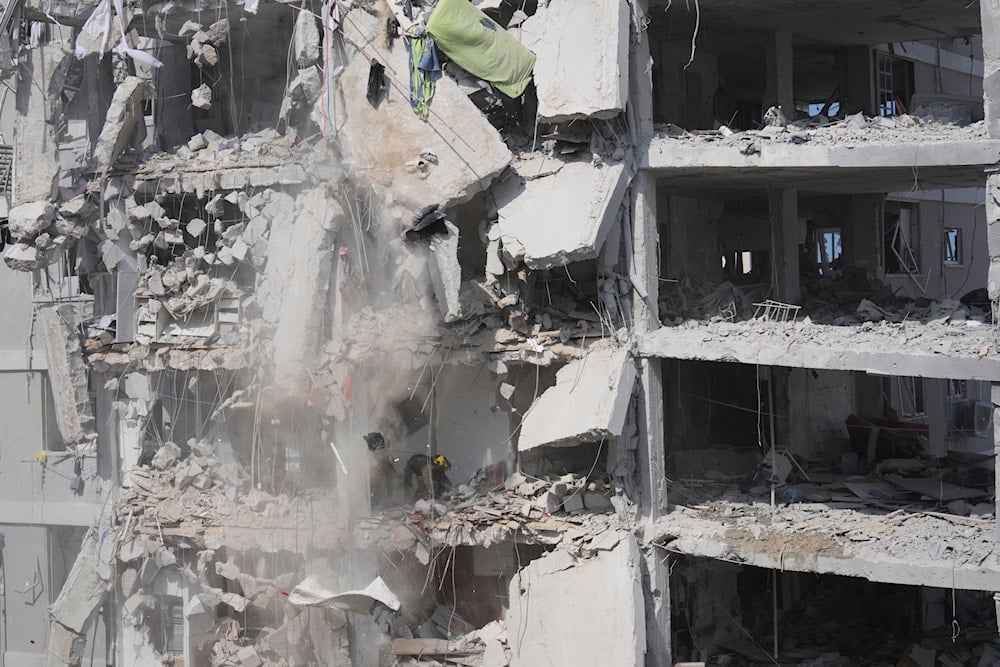Iranian high-tech strikes breach Israeli air defenses: The Telegraph
The Telegraph reveals nearly 10% of Iranian missiles evaded "Israel's" air defenses, exposing system flaws and marking the debut of the Haj Qassem missile.
-

Concrete and rubble fall from a heavily damaged building as Israeli soldiers search for survivors in a residential area hit by a missile fired from Iran, near Tel Aviv, occupied Palestine, Sunday, June 15, 2025. (AP)
Tehran fired more than 200 missiles at "Israel" on Friday and Saturday as part of its retaliation, many of which have penetrated "Israel's" renowned air defenses, forcing the military to warn its people that the defenses were "not hermetic", according to The Telegraph.
According to the news outlet, Iran's targets were not civilian areas, as circulated footage showed missiles landing in and around the Kirya compound, a compound belonging to the Israeli Ministry of Security and known as the Israeli Pentagon.
Another target struck early Sunday morning was the Weizmann Institute, a research hub in Rehovot near Tel Aviv, which overlaps between academic and military domains, as its work, though officially civilian, plays a significant role in Israeli defense technologies.
How did Iran's missiles punch through?
The Telegraph wrote that almost 10% of Iran's missiles have evaded "Israel's" complex air defense network, while highlighting that the IOF refused to provide a number to allegedly avoid offering Iran information it could use for future attacks.
The Iranian airstrikes underscore the challenges faced by even the most advanced air defense systems in countering ballistic missiles, which travel at hypersonic speeds exceeding Mach-5, leaving few surface-to-air missile batteries capable of effectively intercepting them.
"Israel's" "David's Sling" system is among the few capable of intercepting such threats, yet when confronted with simultaneous barrages of dozens of missiles, even this advanced system struggles to maintain full effectiveness.
The greater the volume of missiles launched, the higher the probability that at least one will evade interception and strike its target, with experts suggesting Iran is likely deploying the majority of its ballistic missiles to overwhelm and distract air defenses, thereby creating opportunities for a more sophisticated weapon to penetrate.
Haj Qassem missile marks its first deployment
The missile in question is believed to be the Shahid Haj Qassem, marking its first deployment against "Israel" over the weekend. Reports indicate it boasts an approximate 1,000-mile range and utilizes solid-based fuel technology that allows for underground storage over extended periods before rapid deployment for launch.
See more: Meet Iran’s “Haj Qassem” Missile
Iranian missiles prioritize speed and extended range while sacrificing precision in their design, The Telegraph cited chief executive geopolitical risk Sibylline analyst Justin Crump saying.
Israeli air defenses likely focus on protecting military sites and complexes, at the expense of civilians who could get hit should a missile miss its target.
Iran can continue launching missiles for three weeks
Before launching True Promise 3, Iran was estimated to possess up to 2,000 missiles capable of reaching "Israel", with Tehran dramatically increasing its production in recent years to expand its arsenal, according to the IOF.
“The assessment entering this conflict was that Iran has about 2,000 missiles. We understand they have a plan to increase that number dramatically, to 8,000 missiles, in the near future,” Lt Col Shoshani said on Sunday, according to The Telegraph.
Earlier, Israeli PM Netanyahu had warned that Iran's intensified missile production aimed to manufacture 300 missiles monthly, projecting an arsenal of 20,000 within six years if left unchecked.
Based on these projections and the current launch tempo, Mr. Crump estimated that Iran would exhaust its missile stockpiles within approximately three weeks if maintaining present firing rates.

 4 Min Read
4 Min Read










